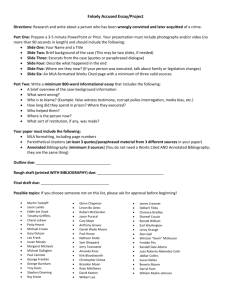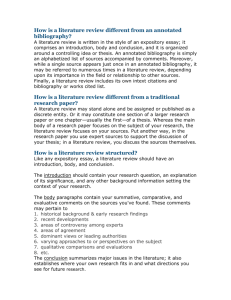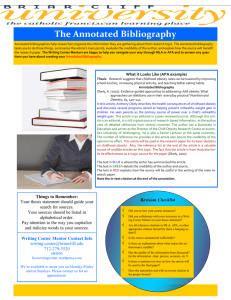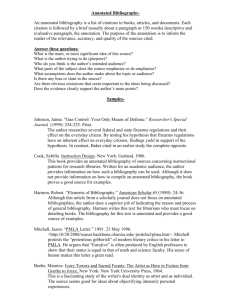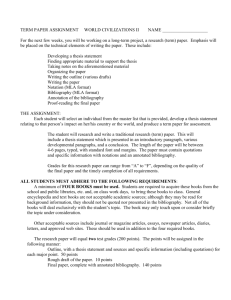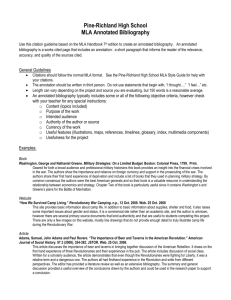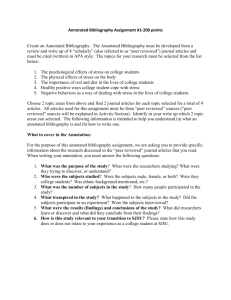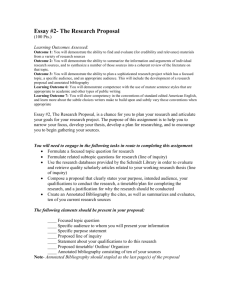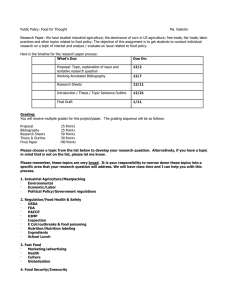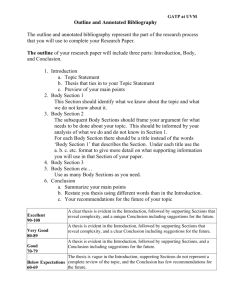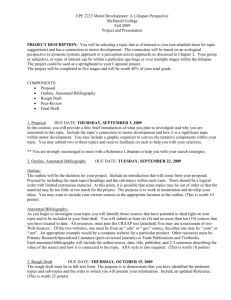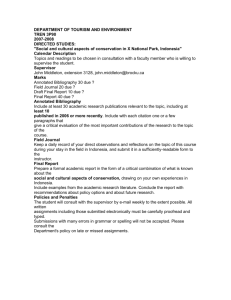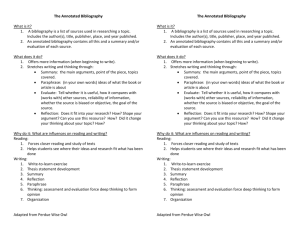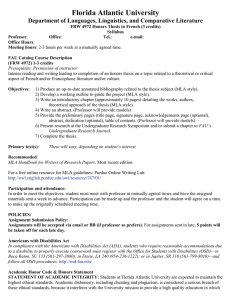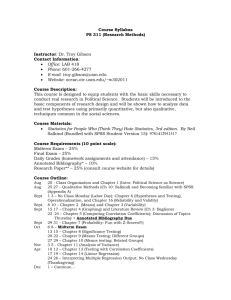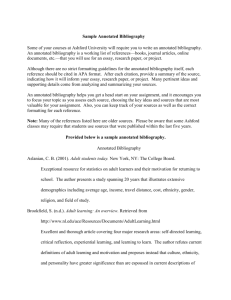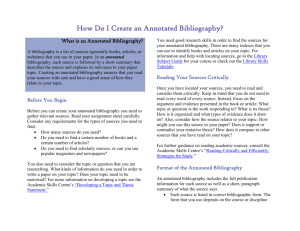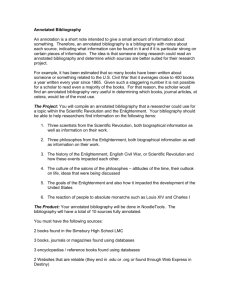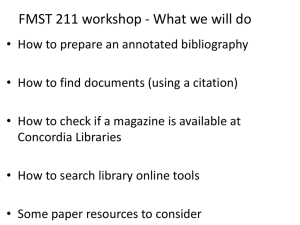Annotated Bibliography
advertisement
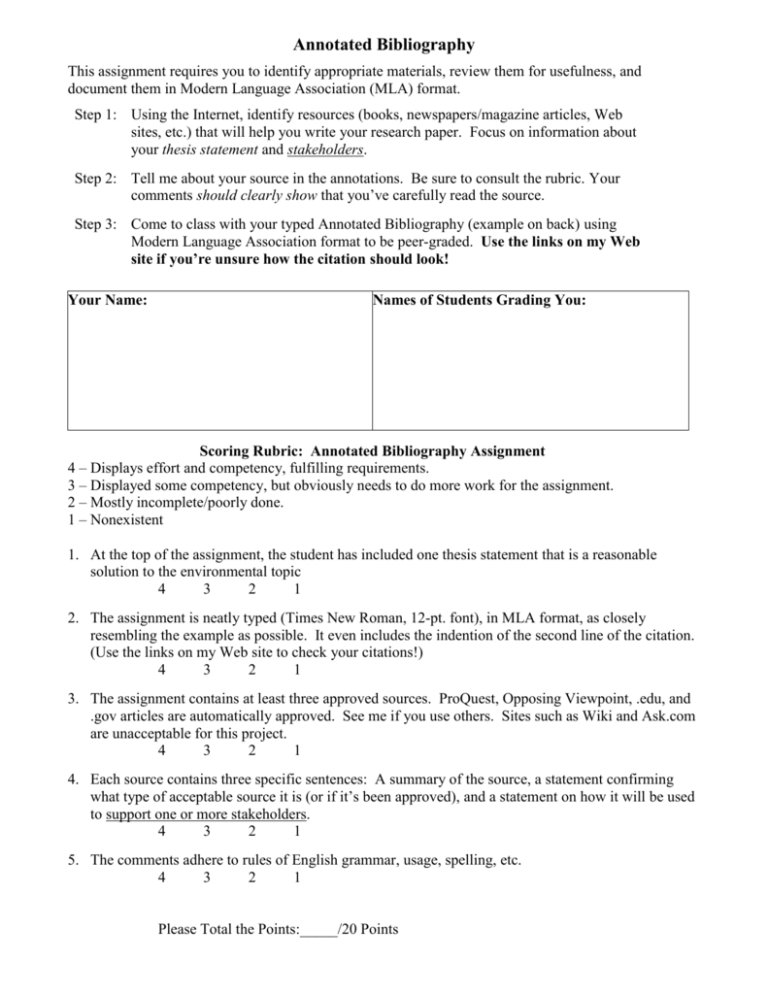
Annotated Bibliography This assignment requires you to identify appropriate materials, review them for usefulness, and document them in Modern Language Association (MLA) format. Step 1: Using the Internet, identify resources (books, newspapers/magazine articles, Web sites, etc.) that will help you write your research paper. Focus on information about your thesis statement and stakeholders. Step 2: Tell me about your source in the annotations. Be sure to consult the rubric. Your comments should clearly show that you’ve carefully read the source. Step 3: Come to class with your typed Annotated Bibliography (example on back) using Modern Language Association format to be peer-graded. Use the links on my Web site if you’re unsure how the citation should look! Your Name: Names of Students Grading You: Scoring Rubric: Annotated Bibliography Assignment 4 – Displays effort and competency, fulfilling requirements. 3 – Displayed some competency, but obviously needs to do more work for the assignment. 2 – Mostly incomplete/poorly done. 1 – Nonexistent 1. At the top of the assignment, the student has included one thesis statement that is a reasonable solution to the environmental topic 4 3 2 1 2. The assignment is neatly typed (Times New Roman, 12-pt. font), in MLA format, as closely resembling the example as possible. It even includes the indention of the second line of the citation. (Use the links on my Web site to check your citations!) 4 3 2 1 3. The assignment contains at least three approved sources. ProQuest, Opposing Viewpoint, .edu, and .gov articles are automatically approved. See me if you use others. Sites such as Wiki and Ask.com are unacceptable for this project. 4 3 2 1 4. Each source contains three specific sentences: A summary of the source, a statement confirming what type of acceptable source it is (or if it’s been approved), and a statement on how it will be used to support one or more stakeholders. 4 3 2 1 5. The comments adhere to rules of English grammar, usage, spelling, etc. 4 3 2 1 Please Total the Points:_____/20 Points Example of How Your Annotated Bibliography Will Look! John Smith 7th Period March 15, 2005 Thesis Statement: Franklin D. Roosevelt’s triumph over personal adversity prepared him to successfully lead America through the Great Depression and World War II. Annotated Bibliography: Bumiller, Elisabeth. “60 Years After the Fact, Debating Yalta All Over Again.” New York Times 16 May 2005, Late Edition (East Coast): New York Times, ProQuest. Web. 28 Jan. 2010. This article examines the recent comments of President Bush concerning President Roosevelt’s diplomatic agreements with Joseph Stalin, the Soviet leader, during World War II. It was in the ProQuest database, an acceptable source for this project. It involved how the citizen of Europe would govern themselves after WWII. Goodwin, Doris. No Ordinary Time. New York: Touchstone, 1995. Print. This book examines President Roosevelt’s personal life, specifically his relationship with his wife. Ms. Goodwin’s research and interviews are well documented/cited. It is a book, which is an acceptable source for this project. The stakeholders were the marginalized Americans who benefited from the programs instituted by the Roosevelt’s efforts. Levy, Richard H. “Jewish Leaders Opposed Bombing Auschwitz.” The New York Times 31 Jan. 1995: A20. Print. This article attempts to clarify the U.S. government’s decision not to destroy Auschwitz, the most prominent of the Nazi concentration camps, during World War. This article is from the New York Times, a major publication acceptable for this project. The stakeholders were the Jewish victims of the holocaust. Loewen, James. Lies My Teacher Told Me. New York: Simon and Schuster, 1995. Print. This book argues that much of the information in American history textbooks misrepresents our Nation’s past, leading us to romanticize events, such as the “discovery” of America and the plight of the Pilgrims. As a book, this source is acceptable for this project. The stakeholders are the students of history who have learned partially truthful “facts” about the past.
